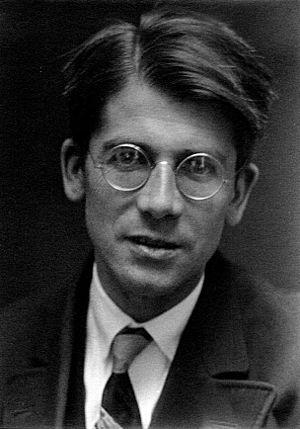Hund's rules facts for kids

Hund's rules are a set of three important rules in atomic physics and quantum chemistry. A German physicist named Friedrich Hund developed them around 1925. These rules help scientists figure out the lowest energy state (called the ground state) for atoms that have many electrons. The first rule is super important in chemistry and is often just called "Hund's Rule."
These rules explain in a simple way how the usual energy interactions decide which electron arrangement has the lowest energy. They assume that the push-back (repulsion) between outer electrons is much stronger than other forces.
Full electron shells and subshells don't affect the total spin or total orbital angular momentum. This means that when we're trying to figure out energy levels, we only need to look at the electrons in the outermost shell.
Contents
Hund's First Rule: Maximum Multiplicity
This rule is about how electrons fill up orbitals. Think of it like people getting on a bus. Each seat (orbital) can hold two people (electrons). But people usually prefer to sit alone first before sharing a seat.
The Pauli exclusion principle says that two electrons can't have the exact same properties in the same space. So, each orbital can only hold two electrons. One electron will have an "up" spin, and the other will have a "down" spin.
Hund's first rule says that the lowest energy state for an atom is when the total spin of the electrons is as high as possible. This means electrons will fill each orbital in a subshell one by one, all with the same spin direction, before any orbital gets a second electron with the opposite spin.
Why does this happen? Electrons in different orbitals are usually further apart. This means they push each other away less, which lowers their energy. Also, electrons with the same spin avoid each other more effectively, which helps reduce repulsion.
Example for Rule 1
| Magnetic quantum levels | -1 | 0 | +1 |
|---|---|---|---|
| Electron occupancy | ↑ | ↑ | |
| The up arrows signify states with up-spin. | |||
| The boxes represent different magnetic quantum numbers. | |||
Let's look at silicon (Si). Its electron setup is 1s2 2s2 2p6 3s2 3p2. We only need to care about the two electrons in the 3p subshell.
Hund's first rule tells us that these two electrons will go into separate 3p orbitals. They will both have the same spin direction (for example, both "up"). This gives the atom the lowest possible energy. The diagram shows this arrangement.
Hund's Second Rule: Largest Orbital Angular Momentum
This rule helps reduce the push-back between electrons even more. Imagine electrons orbiting the nucleus. If all electrons orbit in the same direction, they don't bump into each other as often. This means less repulsion and lower energy.
If some electrons orbit in opposite directions, they meet more often. This increases the repulsive force between them. More repulsion means higher energy for the atom. So, the state with the largest total orbital angular momentum (where electrons orbit in the same general direction) has the lowest energy.
Example for Rule 2
For silicon, the first rule already tells us the lowest energy state, so we don't need the second rule.
Let's consider titanium (Ti). Its electron setup ends with 3d2. After applying the first rule, we might have a few possible low-energy states. Hund's second rule helps us pick the very lowest one. It says the state with the largest total orbital angular momentum (L) will have the lowest energy.
Hund's Third Rule: Total Angular Momentum
This rule looks at how electron spin and orbital motion affect each other. This interaction is called spin–orbit coupling.
- If the outermost electron shell is less than half-filled, the state with the smallest total angular momentum (J) has the lowest energy.
- If the outermost shell is more than half-filled, the state with the largest total angular momentum (J) has the lowest energy.
- If the shell is exactly half-filled, there's only one possible value for J, and that's the lowest energy state.
Examples for Rule 3
For silicon, the lowest energy state has a total angular momentum (J) of 0. This is because its outermost shell (3p) has 2 electrons out of a possible 6, which is less than half-filled.
For sulfur (S), its outermost shell (3p) has 4 electrons out of 6. This is more than half-filled. So, for sulfur, the lowest energy state will have the largest total angular momentum (J), which is 2.
For phosphorus, its outermost shell (3p) has 3 electrons out of 6. This is exactly half-filled. In this case, the total orbital angular momentum (L) is 0, and the total angular momentum (J) is simply equal to the total spin (S), which is 3/2.
Excited States
Hund's rules are mostly used to find the very lowest energy state (the ground state) of an atom or molecule.
They can also be pretty good at finding the lowest energy state for an "excited" electron setup. For example, in a helium atom, Hund's first rule correctly predicts that a certain "triplet state" is lower in energy than a "singlet state."
However, you shouldn't use Hund's rules to figure out the order of *other* excited states. They are best for the ground state and the lowest state of a specific electron arrangement.
See also
 In Spanish: Regla de Hund para niños
In Spanish: Regla de Hund para niños

